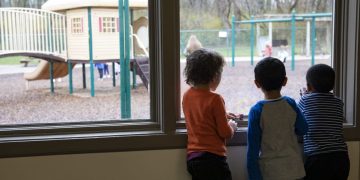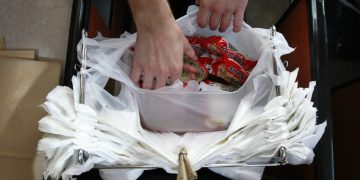The message China’s communist regime is using to hijack Chinese American identity
The People’s Republic of China actively promotes the so-called Chinese American Museum (CAMDC) in Washington, D.C. in its state media. The museum, in turn spreads the regime’s propaganda with its unusual framing of the story of the Chinese in America.
Most Chinese American organizations were founded decades ago, before the rise of the People’s Republic. But Chinese businessman Philip Qiu founded the CAMDC in 2017. Qiu explicitly stated its mission in an article, proudly displayed in the stairwell of the museum itself, from China Daily, which is an official media organ of the Chinese Communist Party. He boasted in the article that the embassy of the People’s Republic of China “spoke highly of our efforts.”
Qiu has also promoted the museum on other communist Chinese state media, including an interview with SinoVision and a segment on CGTN, both of which are registered under the Foreign Agent Registration Act.
The museum, the piece states, aims “to establish ‘the first and only destination in Washington, D.C. dedicated to the Chinese-American story’ because it is the capital.” The implication is that this museum’s name and proximity to power give it authority to dictate who is “Chinese” and even what it means to be an American.
The standard Chinese American immigrant story includes the Gold Rush, the Transcontinental Railroad, the Exclusion Acts, Wong Kim Ark, the San Francisco Earthquake, and Angel Island. But beginning with the period around the emergence of the Chinese Communist Party and World War II, this museum sets that narrative aside in favor of advancing what looks a lot like the current regime’s unrelated political agenda.
For example, the Magnuson Act of 1943, which increased immigration quotas from China, is mentioned, but it goes unmentioned that this was because of the U.S. alliance with the Republic of China — the entity that later became Taiwan. That war’s veterans are also being co-opted, because that war represents the last time the U.S. was aligned with any Chinese government.
In an attempt to link Japan to the Holocaust, this museum also features Jewish refugees in Shanghai during the war (again, they took refuge in the Republic of China), even though this has nothing to do with Chinese Americans at all. This is another clear example of the museum, supposedly about Chinese Americans, promoting the Chinese Communist Party’s foreign policy agenda.
Although Chinese Americans who fought in the U.S. Civil War are featured in the museum, Chinese American participation in the Korean War, in which the U.S. and the United Nations fought against communist China, is minimized.
At every point, the museum also minimizes the internal turmoil that actually caused most Chinese emigration, as this would run counter to the regime’s perpetual victim-narrative about China’s “Century of Humiliation” under domination by Western powers
For example, although the Immigration Act of 1965 is mentioned as an impetus for increased Chinese migration to the U.S., the distinct role of communism in bringing about so much emigration is papered over. The waves of Chinese immigration from outside of China during the 1970s, 1980s, and 1990s go unmentioned — from Vietnam (whose “boat people” included many ethnic Chinese), Hong Kong (to escape China’s takeover) and Taiwan.
Speaking of which , this museum does not like to dwell at all on Taiwanese immigrants, despite their large role in the Chinese American community. They were mostly the descendants of those who had resisted the People’s Liberation Army and fled to the island at the end of the Chinese Civil War.
The Chinese Student Protection Act of 1992, which gave permanent residency to Chinese students in the U.S., is also mentioned. What goes unmentioned is that this was a direct result of the Tiananmen Square massacre by the Chinese communists.
In the 1990s and 2000s, mainland China’s One-Child Policy and the cultural preference for sons resulted in the adoption and trafficking of 120,000 girls, 85,000 of whom were adopted in the U.S., not always by ethnic Chinese families. These American Chinese receive no mention in this museum.
Also ignored are several other groups of Chinese who emigrated first to the Caribbean, Latin America, and Southeast Asia, often intermarrying and converting to Christianity before migrating again to the U.S.
Likewise absent from this museum is the story of assimilation by Chinese immigrants, the development of layered and pan-ethnic Asian-American identities, and the inconvenient truth that the majority of Chinese Americans dislike China’s current regime. In fact, half of them no longer identify as Chinese at all.
Qiu has claimed that for Chinese Americans, “it’s not easy for them to be part of mainstream society,” which is why “fourth or fifth-generation Chinese Americans,” who supposedly “know little about Chinese culture,” need to be reintroduced to their cultural roots.
But this also smacks of regime propaganda, which is designed to alienate Chinese Americans from their new culture and imply that they owe some kind of loyalty to the modern Chinese communist state. China’s Minister of Foreign Affairs has argued to Chinese people abroad, “No matter how blonde you dye your hair, how sharp you shape your nose, you can never become a European or American. You can never become a Westerner.”
The 1982 murder of Vincent Chin is featured in the museum, but not the fact that it was caused by anti-Japanese sentiment. Internment of Japanese Americans is also mentioned, but not the fact that Chinese Americans were among those who exploited them.
Attacks on Sikhs in the U.S. after 9/11 are featured, but not attacks against Muslims — that would contradict the rationale behind China’s ethnic cleansing of its Islamic Uyghur minority.
The distinctly anti-American part of this museum’s propaganda message includes veneration of the year 1882 and the Exclusion Acts, in partnership with the 1882 Foundation. This other recently founded D.C. organization also works to spread propaganda about Chinese Americans never being able to become truly American or truly accepted in the U.S.
What I have outlined above is symptomatic of China’s “United Front” strategy to gain influence overseas and provoke racial strife and internal divisions. China wants Chinese Americans to believe that they are perpetual foreigners who will never be accepted as true Americans.

This museum takes precious few risks to showcase the diversity among Chinese American communities that might contradict the Communist Party’s “one China” political narrative and its artificial “one Han Chinese race” cultural narrative. There are no maps of the old China from which many Chinese American families emigrated; there is little mention of the role of traditional versus simplified Chinese characters; no discussion of the varying transliterations of family names resulting from the diverse national origins of Chinese Americans; nothing about the transition over time from Cantonese to Mandarin in Chinese-speaking American communities.
The pattern of this museum’s curious, frequently inappropriate choices of what to omit and what to include raises several red flags. It seems designed to undermine our image of America as the welcoming country in which millions of Chinese have made their home. It would be a big mistake to take this soft-power propaganda at face value, as if it were a genuine expression of the Chinese American experience.
Ryan Quinn is a military veteran with experience in defense, intelligence, and foreign policy.
regular post copyright









